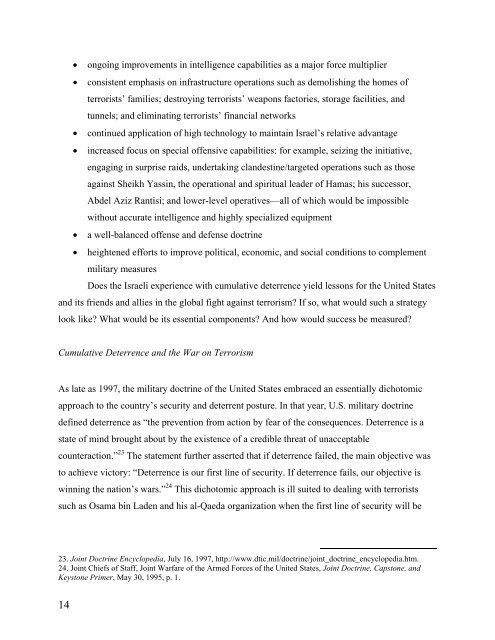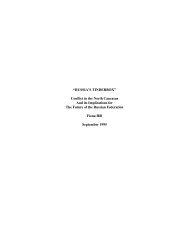Cumulative Deterrence and it's implementations to the War against ...
Cumulative Deterrence and it's implementations to the War against ...
Cumulative Deterrence and it's implementations to the War against ...
Create successful ePaper yourself
Turn your PDF publications into a flip-book with our unique Google optimized e-Paper software.
• ongoing improvements in intelligence capabilities as a major force multiplier<br />
• consistent emphasis on infrastructure operations such as demolishing <strong>the</strong> homes of<br />
terrorists’ families; destroying terrorists’ weapons fac<strong>to</strong>ries, s<strong>to</strong>rage facilities, <strong>and</strong><br />
tunnels; <strong>and</strong> eliminating terrorists’ financial networks<br />
• continued application of high technology <strong>to</strong> maintain Israel’s relative advantage<br />
• increased focus on special offensive capabilities: for example, seizing <strong>the</strong> initiative,<br />
engaging in surprise raids, undertaking cl<strong>and</strong>estine/targeted operations such as those<br />
<strong>against</strong> Sheikh Yassin, <strong>the</strong> operational <strong>and</strong> spiritual leader of Hamas; his successor,<br />
Abdel Aziz Rantisi; <strong>and</strong> lower-level operatives—all of which would be impossible<br />
without accurate intelligence <strong>and</strong> highly specialized equipment<br />
• a well-balanced offense <strong>and</strong> defense doctrine<br />
• heightened efforts <strong>to</strong> improve political, economic, <strong>and</strong> social conditions <strong>to</strong> complement<br />
military measures<br />
Does <strong>the</strong> Israeli experience with cumulative deterrence yield lessons for <strong>the</strong> United States<br />
<strong>and</strong> its friends <strong>and</strong> allies in <strong>the</strong> global fight <strong>against</strong> terrorism? If so, what would such a strategy<br />
look like? What would be its essential components? And how would success be measured?<br />
<strong>Cumulative</strong> <strong>Deterrence</strong> <strong>and</strong> <strong>the</strong> <strong>War</strong> on Terrorism<br />
As late as 1997, <strong>the</strong> military doctrine of <strong>the</strong> United States embraced an essentially dicho<strong>to</strong>mic<br />
approach <strong>to</strong> <strong>the</strong> country’s security <strong>and</strong> deterrent posture. In that year, U.S. military doctrine<br />
defined deterrence as “<strong>the</strong> prevention from action by fear of <strong>the</strong> consequences. <strong>Deterrence</strong> is a<br />
state of mind brought about by <strong>the</strong> existence of a credible threat of unacceptable<br />
counteraction.” 23 The statement fur<strong>the</strong>r asserted that if deterrence failed, <strong>the</strong> main objective was<br />
<strong>to</strong> achieve vic<strong>to</strong>ry: “<strong>Deterrence</strong> is our first line of security. If deterrence fails, our objective is<br />
winning <strong>the</strong> nation’s wars.” 24 This dicho<strong>to</strong>mic approach is ill suited <strong>to</strong> dealing with terrorists<br />
such as Osama bin Laden <strong>and</strong> his al-Qaeda organization when <strong>the</strong> first line of security will be<br />
23. Joint Doctrine Encyclopedia, July 16, 1997, http://www.dtic.mil/doctrine/joint_doctrine_encyclopedia.htm.<br />
24. Joint Chiefs of Staff, Joint <strong>War</strong>fare of <strong>the</strong> Armed Forces of <strong>the</strong> United States, Joint Doctrine, Caps<strong>to</strong>ne, <strong>and</strong><br />
Keys<strong>to</strong>ne Primer, May 30, 1995, p. 1.<br />
14
















